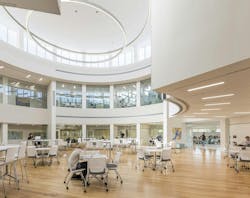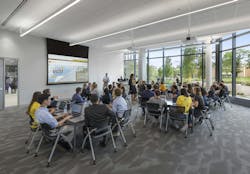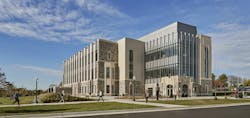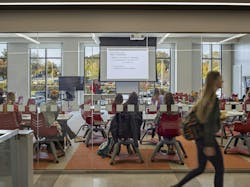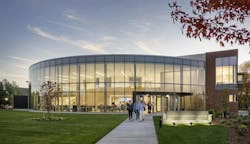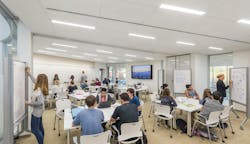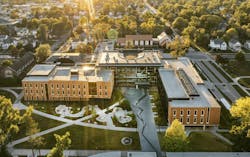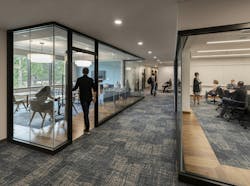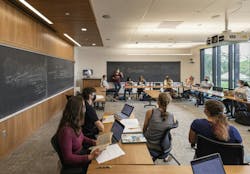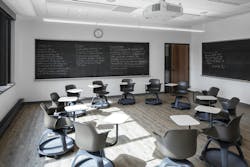The evolution of academic spaces and active learning classrooms
This blog is authored by Shayne Sobell, AIA, NCARB, Project Academic Planner, Page; and Melissa Burns AIA, LEED AP BD+C, Lead Academic Planner and Principal, Page.
Active Learning Classrooms (ALCs) are the vanguard of current pedagogical space design. They enhance student engagement, improve learning outcomes, and prepare students for life in the workforce. Page Lead Academic Planner Melissa Burns, AIA, and Project Academic Planner Shayne Sobell, AIA, explore why the traditional instructional model has evolved and the space requirements that accompany this change.
Flexibility and Adaptability for the Future
Most university buildings survive 50 or more years. Over that duration, there will likely be numerous improvement projects to keep up with the changing demands of the day. The world is rapidly changing, and higher education is on the forefront of this change in order to meet the needs of current and future collaborative learning environments. We believe it is important to consider in the design process that change is inevitable and facilities need to be designed to allow for change to happen without significant impact to the infrastructure that we create. Flexibility down to the room level can be achieved by using a variety of strategies including installation of moveable furnishings, which support multiple room modalities, and the incorporation of flexible infrastructure.
Acoustics: From an acoustical standpoint, collaborative and flexible spaces present an interesting challenge. Whether related to a challenging geometry, or in rooms without a “front”, acoustic design needs to be closely coordinated with the interior design and the teaching/collaboration systems. To avoid unwanted echoes or odd sound reflections from surfaces, sound absorptive treatments must be carefully integrated into the design to achieve excellent speech intelligibility, with care taken to not introduce too much treatment to avoid making rooms feel lifeless and unengaging.
Audio/Visual: Many learning spaces feature more sophisticated audio/video systems that demand a specific acoustic environment in order to optimize performance. Such systems need to be sophisticated enough to satisfy the needs of these active learning spaces, while also being intuitive and user-friendly. They must also have an eye towards the future as technology in these environments changes at a faster pace than in other building systems. Integrating additional infrastructure can facilitate the ability to modernize these systems with minimal impact to the operations of the building.
Enhanced Student Engagement
ALCs move from a traditional didactic, lecture-based learning experience where the student is a passive participant to an interactive learning experience where the student is an active participant. Today’s classroom environments must accommodate multi-modal presentations and group learning, as well as the traditional pedagogical system of text-based lectures and testing; all within a single space.
These classrooms support students in communicating their thoughts and ideas for reaction from teammates. They aren’t necessarily following a predetermined path to a predetermined solution, but rather combining competing interests and ideas into an imperfect solution. A solution that strives for as many positive outcomes as possible while allowing for accepted drawbacks and imperfections.
The ever-changing modern workplace increasingly relies on groups of people, rather than individuals, to solve complex problems. The skill of ideating solutions for complex problems is married with the challenges of communicating ideas and navigating interpersonal relationships. The power of active learning classrooms is the opportunity for students to develop knowledge while honing personal social networking skills and gaining confidence in communicating their ideas and what they’ve learned.
Virginia Tech New Classroom Building
Virginia Tech’s New Classroom Building is a pioneering active learning facility intended for use by any of the university’s degree programs. The goal is to further the university’s mission to “invent the future” with innovative learning environments. The building contains several active learning classrooms filled with natural light and glass walls to the corridor.
In addition to putting learning on display, the large glass walls to the corridor invite student study in the classrooms when they are not in use. This transforms the building into a 24-hour environment where large learning studios serve as classrooms by day and student study halls by night.
In addition to traditional active learning classrooms with flexible furniture, the building contains two SCALE-UP classrooms. SCALE-UP is an acronym for Student Centered Active Learning Environments for Undergraduate Programs. The classrooms are furnished with fixed seven-foot round tables determined to be the optimal size for interaction, according to North Carolina State University research.
The tables are outfitted with microphones, power cords, and cable connections to monitors around the room. Nine students work in three groups of three, collaborating on real-world science problems.
At the top floor of the building, there are four “classatories” that blend the elements of a team-based flexible classroom with a teaching laboratory to support the university’s Integrated Science Curriculum. Within a single class period, students work in several scientific disciplines (such as biology, chemistry, and physics). The rooms provide group benches with the ability to pull end tables to the center of the room for a full class demonstration.
In addition to the spaces noted above, the building contains a series of collaboration spaces where students can gather in teams or work individually. Feedback has been very positive, making the facility the most popular classroom building on campus.
Bryant University Academic Innovation Center
Curiosity, collaboration, interactive teaching, and active learning are clearly on display when stepping through the open, light-filled halls of the Academic Innovation Center (AIC) at Bryant University in Smithfield, Rhode Island.
Boasting high-tech classrooms that encourage debate and communication skills, the AIC creates an environment conducive to innovative teaching and active learning. Adjacent meeting and study spaces inspire creative solutions to problems explored in the classrooms. Features such as abundant natural light, plentiful glass walls and floor-to-ceiling whiteboards energize students to solve problems with one another while writing, sketching, and drawing ideas that are visible to all.
At the heart of the building is the Innovation Forum—an immersive central core and activity hub where students gather for workshops, break into small groups, and meet with industry partners. Theory meets practice as faculty, students, and corporate partners gather to tackle real-world business challenges.
Grinnell College Humanities and Social Sciences Complex
The Humanities and Social Studies Center (HSSC) at Grinnell College in Grinnell, Iowa, brings together 15 humanities departments under one roof. The complex reimagines two historic buildings and combines them with new learning pavilions. The departments are grouped into interdisciplinary neighborhoods with epicenters of shared resources and collaboration spaces to foster dialogue.
An important component of the building program was instructional space, including a large number of classrooms to accommodate a myriad of different studies. The 40 classrooms range in size from 12 to 36 students and support varying forms of lecture, presentation, discussion, and group work.
Because of the seat count and size, some of the active learning classrooms can also be reconfigured into seminar classrooms, both bringing participants into a singular conversation. Following the Socratic method, there is a democratic dialogue between the faculty and students asking and answering questions, arguing different interpretations or points of view.
Grinnell also has a strong desire for their classrooms to be more inclusive and accessible than what is commonly prescribed by the Americans with Disabilities Act (ADA). The power of active learning classrooms is that their flexible nature allows for those with mobility challenges to have more options of where to participate and maneuver within the learning space, rather than just in the front or back of the room.
With flexible AV systems, we also can accommodate those with sensory challenges, so they, too, feel included in the learning environment.
Grinnell College made a significant investment in modern classrooms and departmental space in its new Humanities and Social Sciences Center. The College has shared with our team that the return on that investment is reflected in their successful graduates being well-prepared for life beyond Grinnell, strong enrollment demand, and exceptional retention.
Their ability to recruit and retain exceptional faculty is enabled by the enthusiasm faculty has for the College’s leading-edge academic facilities and innovative academic programming of the highest caliber.
Want more? Check out The Good Classroom on The Good Room Podcast.
